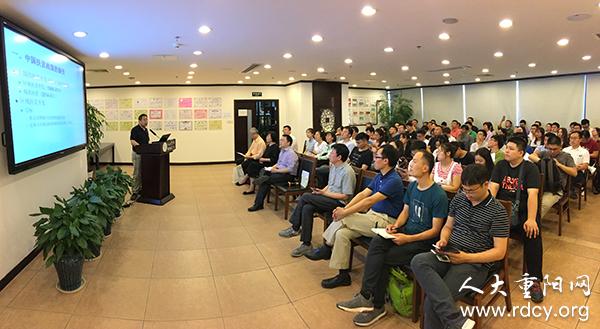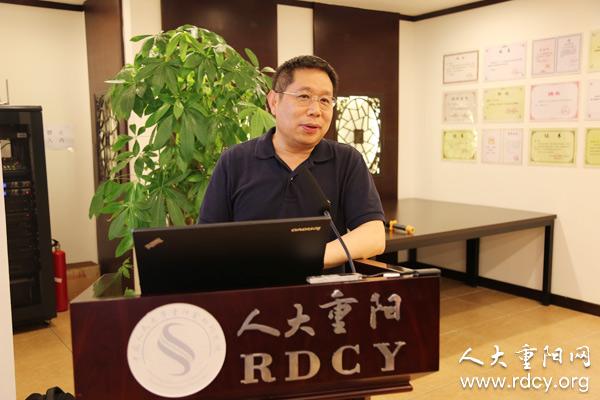Picture
Your Present Location: HOME> PictureProfessor Wang Sangui's lecture on "Situation and Future of Targeted Poverty Alleviation" held in RDCY
On June 10, 2019, a lecture on "The Situation and Future of Targeted Poverty Alleviation" was held at Chongyang Institute for Financial Studies of Renmin University of China (RDCY). Wang Sangui, a professor at the School of Agriculture Economics and Rural Development of Renmin University of China, was invited to share the experience and trend of poverty alleviation in China. The lecture was moderated by Liu Yushu, a research fellow at the RDCY.

Wang Sangui said that poverty is a global problem, and China's poverty alleviation began with the reform and opening up. At the beginning of reform and opening up, China promoted rural economic development through rural reform to achieve poverty reduction. The large-scale poverty alleviation process began in the mid-1980s, and that can be roughly divided into two stages. The first stage is regional poverty alleviation (1986-2013), mainly through the faster development of poor areas to lift the poor out of poverty. The main target of poverty alleviation at that stage is poor counties, and counties and villages are both supported in 2011. At this stage, China's poverty alleviation work has achieved remarkable results. The second stage is targeted poverty alleviation, starting at the end of 2013.
Regional poverty alleviation and development has achieved the expected goals, and has indeed played a very important role in promoting the development of poor areas. Relying on economic development to lift people out of poverty has achieved remarkable results for the poor with strong personal ability. But when the number of poor people falls from 700-800 million to less than 100 million, it becomes increasingly difficult for the poor to benefit from economic growth.
At present, more than 40% of the people who are registered for poor due to illness, and many of them have very weak labor capacity and low level of education. Therefore, the effect of poverty reduction by economic growth is getting worse and worse. More targeted measures must be taken before we can successfully lift all poor households out of poverty by 2020.
Wang Sangui stressed that the goal of targeted poverty alleviation at the current stage is no longer for the purpose of raising absolute living standards, but to focus on ensuring compulsory education, basic medical care, and safe housing.

He added that targeted poverty alleviation embraces a lot of welfare measures, such as poverty alleviation in characteristic industries, poverty alleviation in employment, ecological compensation, relocation of poverty people in different places, renovation of dilapidated houses, poverty alleviation through education, by health, social security. However, many difficulties will be encountered in the implementation of the policies, and not exactly the same at different stages, such as the accurate identification, the lack of the internal motivation. Therefore, the central authorities have repeatedly reviewed and evaluated the polices implemented and called for the establishment of a stable income-generating mechanism at the same time.
Professor Wang noted that we will successfully achieve the goal of lifting ourselves out of poverty by 2020, but this does not mean that our country will no longer need poverty alleviation, and no country in the world has claimed to have eliminated poverty. He emphasized that poverty is a long-term historical phenomenon that needs to be solved in stages, and that different stages will have different goals. Europe and the United States usually take relative poverty as the standard of identification, that is, to a certain extent poorer than other people can be identified the poverty people, rather than looking at the absolute standard of living.
After 2020, the regular poverty alleviation work is mainly realized through the institutionalized channels such as the integration of urban and rural poverty alleviation, cultivating the self-development ability and endogenous motivation of the poor, developing professional non-governmental organizations, and perfecting the social security system, Professor Wang said.
At the end of the lecture, Professor Wang had a warm interaction with the audience and expressed his confidence and expectation of lifting poor out of poverty in an all-round way.























































































 京公网安备 11010802037854号
京公网安备 11010802037854号





